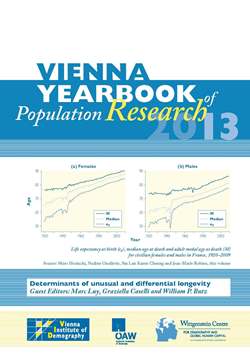
Vienna Yearbook of Population Research 2013, pp. 295-323, 2014/04/30

Studies of centenarians are useful in identifying factors leading to long life and avoidance of fatal diseases. In this article we consider several approaches to study effects of early-life and midlife conditions on survival to advanced ages: use of non-biological relatives as controls, the within-family analysis, as well as a sampling of controls from the same population universe as centenarians. These approaches are illustrated using data on American centenarians, their relatives and unrelated shorterlived controls obtained from the online genealogies. The within-family analysis revealed that young maternal age at person’s birth is associated with higher chances of exceptional longevity. Comparison of centenarians and their shorter-lived peers (died at age 65 and sampled from the same pool of online genealogies) confirmed that birth timing in the second half of the calendar year predicts survival to age 100. Parental longevity as well as some childhood and midlife characteristics also proved to be significant predictors of exceptional longevity.